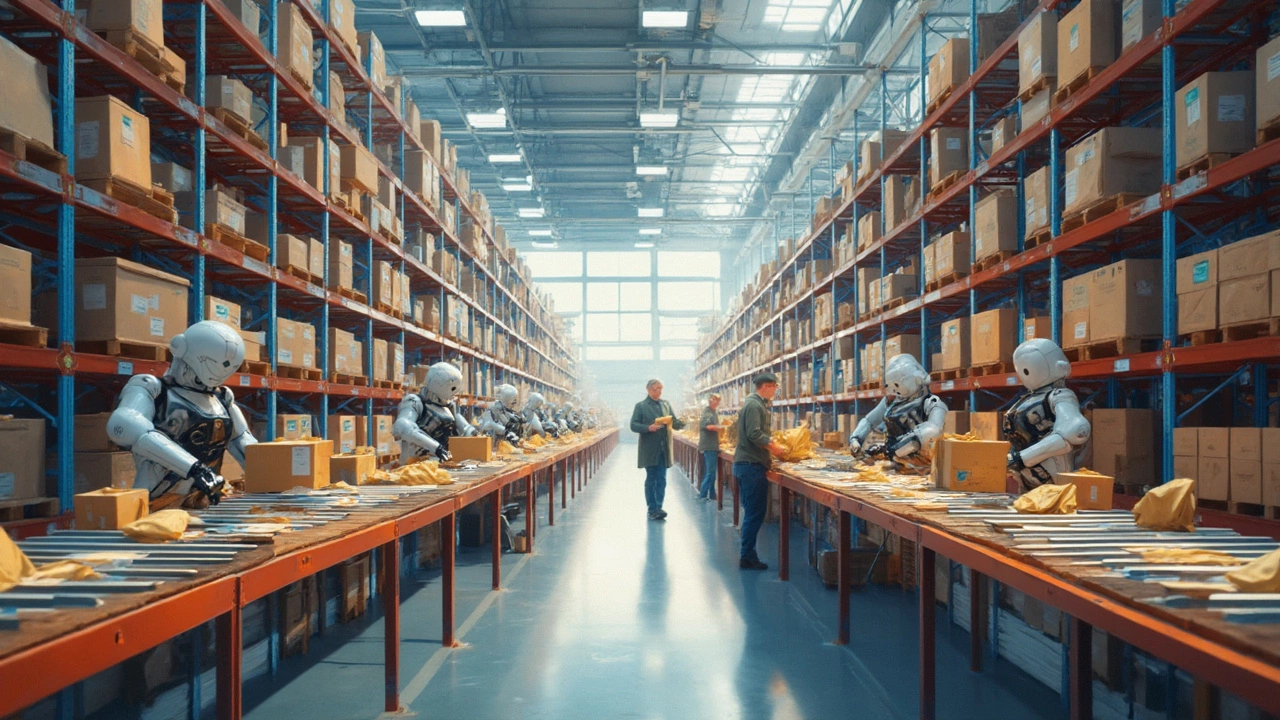Amazon's story is a remarkable journey from humble beginnings to becoming a household name in e-commerce. Founded in 1994 primarily as an online bookstore, Amazon now sells just about everything. It's pretty impressive how they cracked the logistics code to make shopping online so seamless.
How did they do it? Well, Amazon's logistics network is not just about warehouses and trucks. They innovate constantly, trying new things like drone deliveries and investing in AI to pack and ship items faster and cheaper. Understanding this logistics wizardry can be super helpful for smaller businesses trying to up their game.
- Amazon's Rise to the Top
- Logistics Innovations
- Impact on Competition
- Customer Experience
- Learning from Amazon
- Future of E-commerce Logistics
Amazon's Rise to the Top
When Amazon first hit the scene in 1994, selling books online was a pretty radical concept. Jeff Bezos, the founder, had a vision that was super forward-thinking—getting customers anything they want from the comfort of their homes. The decision to start with books was strategic because they had a universal demand and were easy to ship.
Fast forward to today, and Amazon's not just about books. It's a massive marketplace offering almost anything you can think of—clothes, electronics, even groceries. This transformation didn’t happen overnight. It was a mix of experimentation, smart moves, and some risk-taking. But the real magic lies in its logistics operations, turning it into the e-commerce leader it is now.
One of the more significant moments in Amazon's history was the launch of Prime in 2005. This subscription service changed the game by offering free, fast shipping. It made online shopping more appealing and convenient than heading to the store. Today, Prime has over 200 million members worldwide and is a big reason why Amazon is still on top.
Strategic Partnerships and Acquisitions
Amazon didn't go it alone. They made strategic partnerships and acquisitions a big part of their strategy. For instance, acquiring Whole Foods in 2017 wasn't just about selling groceries online; it opened the door to the brick-and-mortar world. Plus, the Amazon Web Services arm is a testament to diversifying while supporting their core operations with powerful cloud infrastructure.
Data-Driven Decisions
Nowadays, Amazon is all about data. Everything from product recommendations to logistics is driven by algorithms crunching numbers. This data-centric approach helps them keep ahead of the curve, designing experiences and operations that cater to individual customer needs.
So, how does Amazon remain the most popular e-commerce company? It boils down to constantly evolving and never getting too comfortable. They look at what's working, what's not, and don't hesitate to pivot if it means better service and happier customers. It's a good lesson for anyone in business—stay curious and keep innovating.
Logistics Innovations
Amazon has turned logistics into an art form, making massive strides that keep them ahead in the e-commerce arena. They don’t just rely on traditional delivery methods; they’re always pushing the boundaries with new tech and strategies.
Robots and Automation
Inside Amazon's fulfillment centers, robots play a huge role. They’re not here to replace humans but to do the heavy lifting. These robots, which lift and move shelves, make the order picking process a lot faster and less prone to errors. It’s a clever way to maximize efficiency.
Same-Day Delivery
Same-day delivery might sound like a logistical nightmare, but Amazon makes it work. How? By strategically placing their warehouses close to major urban centers. This decreases delivery times and helps them keep their promise of getting stuff to your door shockingly fast.
Amazon's Drone Delivery
Amazon Prime Air is the company’s ambitious project to deliver packages via drones. It's not just a gimmicky experiment. The goal is to deliver packages up to five pounds in under 30 minutes. While still in its testing phases, this could seriously change how we think about delivery.
Data and Predictive Analytics
This might not sound exciting, but Amazon’s use of data is one of their biggest strengths. They crunch a crazy amount of data to predict what customers in certain areas are likely to buy. This means they can stock the right products in the right places, reducing shipping time and costs.
| Innovation | Impact |
|---|---|
| Robotics | Speeds up order processing |
| Same-day Delivery | Increases customer satisfaction |
| Drone Delivery | Potentially reduces delivery times further |
| Predictive Analytics | Optimizes inventory placement |
These innovations make Amazon a powerhouse in logistics and e-commerce, keeping them not just on top but way ahead of many competitors. And who knows what they'll think of next?
Impact on Competition
Amazon's influence on the e-commerce landscape is nothing short of monumental. With its dominance, it has nudged countless businesses to rethink how they approach e-commerce and logistics. While some competitors struggle to keep up, others have leveraged Amazon's success as a blueprint for growth.
Firstly, consider the price wars. Amazon's ability to offer incredibly low prices squeezes its competitors. Many retailers find themselves cutting margins to stay competitive. Smaller businesses feel the heat more intensely because they can't match the economies of scale that Amazon enjoys.
Innovation and Adaptation
Amazon sets a high bar in logistics, forcing others to adapt quickly. Companies investing in advanced logistics technologies, like automated warehouses, often cite Amazon as their inspiration. This trickle-down effect means even startups or small retailers are now looking into AI and automation to streamline operations.
If you've been around during the holiday season, you've probably noticed how extra competitive shipping gets. With Amazon's warehouse network, they're able to promise rapid delivery. Other retailers have to fast-track their logistical capabilities to avoid sidelining their customers.
Marketplace Dynamics
It's not just about services; it's about the marketplace itself. Amazon opens a platform for third-party sellers, creating an additional layer of competition within its ecosystem. Interestingly, this has served as both a challenge and an opportunity. Retailers can either compete with these third parties or join them, using Amazon's platform to reach millions of customers they wouldn't otherwise get.
Here's a quick look at the numbers showing Amazon's impact on market share:
| Year | Amazon's Market Share (%) |
|---|---|
| 2020 | 37.3 |
| 2021 | 38.7 |
| 2023 | 39.5 |
These figures hint at a constant mild growth, showing how Amazon not just holds ground but also gradually expands its influence.
In the end, while Amazon's reign is difficult to dethrone, it pushes the boundaries of how other e-commerce entities innovate. Whether through underdog grit or strategic alliances, competitors are finding ways to coexist and thrive in a market where Amazon is a giant.

Customer Experience
When it comes to Amazon, what sets them apart is their unwavering focus on customer experience. From the moment you log onto the site to the second your package hits your doorstep, the entire process is smooth, efficient, and designed to keep you coming back for more.
Easy Navigation and Search
Amazon's platform is designed for ease of use. With intuitive navigation and a powerful search engine, it's practically a breeze to find what you're looking for. A staggering 95% of their product searches lead customers directly to the item they need without hassle. It’s all about making the shopping process as painless as possible.
Prime and Fast Delivery
Probably the hallmark of Amazon's service, their Prime membership offers customers free and fast shipping, often within two days or less. Additionally, the logistics marvel doesn't stop there; in select areas, they even offer same-day delivery. No wonder the average Prime member reportedly spends over twice what a non-member does on the platform!
Innovations in Customer Service
Beyond fast delivery, Amazon knows that keeping customers happy requires stellar service. Their 24/7 customer support is top-notch, with dedicated call centers and chat support that resolve issues quickly. Plus, their hassle-free return policy means you can shop with peace of mind.
Personalization and Recommendations
Ever notice how Amazon seems to know what you want before you do? Their recommendation algorithms use past purchase data and browsing habits to suggest products tailored specifically to you, leading to higher satisfaction and increased sales revenues.
Amazon's combination of speed, simplicity, and service continues to define the e-commerce landscape, offering valuable lessons to anyone looking to improve their own business’s customer experience.
Learning from Amazon
Amazon isn’t just a shopping site; it's practically an endless vault of lessons for businesses. Whether you run a small online store or a massive operation, there's a lot to learn from how Amazon handles their logistics and customer experiences.
Customer-Centric Approach
One of the most important things to grasp from Amazon is their focus on the customer. They have a saying: 'Start with the customer and work backward.' By focusing on what customers want, from speedy delivery to a hassle-free returns policy, they’ve set the standard high.
Innovative Logistics
Amazon's logistics network is a beast of efficiency. Their fulfillment centers are strategically placed, and they use a mix of technology and clever data to keep items moving without a hitch. Small businesses might not need the same scale, but thinking about logistics smartly—like predicting peak times and stocking up—can make a big difference.
They even experiment with tech-forward ideas like drone deliveries and have their own delivery fleet, showing that being bold can pay off. Here's a cool stat: They own over 175 fulfillment centers around the world!
Investing in Technology
Amazon is always investing in technology, whether it's for better tracking, warehouse robots, or even smart algorithms that predict what you might buy next. Smaller e-commerce businesses can look into what's practical for them—like using AI for inventory management or simple chatbots for customer service.
Adapting and Learning
A big part of Amazon's success is how they adapt to changes and learn from their mistakes—like when they launched the Fire Phone, which was a flop, they pivoted to other tech ventures like Alexa that's now a household fixture. Businesses should never rest on their laurels and always be ready to pivot when needed.
| Lesson | Description |
|---|---|
| Customer Focus | Always think from a customer's perspective—Amazon's key to long-term relationships. |
| Efficient Logistics | Optimize your supply chain, even on a small scale. Think smart and save costs. |
| Technology Investment | Use tech to streamline processes. Keep up with what’s new and useful. |
| Resilience | Learn and adapt from failures—pivot quickly when something doesn't work. |
So, if you're trying to learn from the e-commerce leader, start by thinking big but acting practically. Take a leaf from Amazon's book and get creative with how you approach your business, always prioritizing logistics and customer satisfaction.
Future of E-commerce Logistics
What's next for the world of e-commerce logistics? If you've been following technological trends, the future looks both exciting and kind of wild. As we propel forward, we’re seeing a blend of emerging technology, sustainability efforts, and changing customer expectations molding the landscape.
Automation and AI
Amazon isn't the only one investing heavily in robots and AI tools to streamline operations. We're talking about fully automated warehouses where robots do the picking and packing. AI will continue to optimize routes for delivery trucks, shrinking delivery times and costs. Imagine a system where your online order gets packed faster than it takes to brew a cup of coffee.
Drone Deliveries and Beyond
Drones aren't futuristic anymore—they're happening now. While Amazon has been teasing this tech for a while, other companies are joining the race. Though there are regulatory hurdles to manage, expect drones to become more common, delivering packages in less time.
Sustainability Drives Change
With climate change becoming more pressing, companies are searching for ways to make e-commerce more eco-friendly. Think electric delivery vehicles to cut down on emissions or eco-friendly packaging that scraps single-use plastics. Consumers care about this stuff, and businesses will need to adapt. You might even see companies offering incentives for choosing green delivery options.
Hyperlocal Fulfillment Centers
Setting up micro-warehouses in urban areas helps companies tackle the 'last mile' problem. These hyperlocal setups mean faster deliveries and less congestion, making everyone's life a little easier. Particularly for dense city areas, this could well be the future.
Omnichannel Shopping Experiences
Blending online and offline experiences is more than just a buzzword. People want the option to shop online but pick up in-store quickly. This means logistics have to be on point, ensuring real-time inventory updates and seamless transitions between different platforms.
E-commerce logistics is shifting fast, and those who adapt will thrive in this new age of online shopping. With technology advancing, expect these changes sooner than you might think. It’s a good reminder for businesses to stay flexible and innovative.


